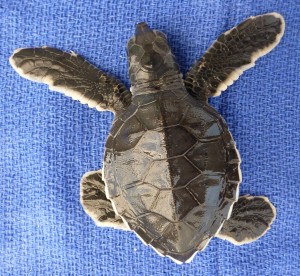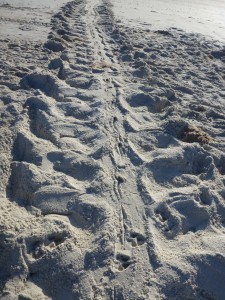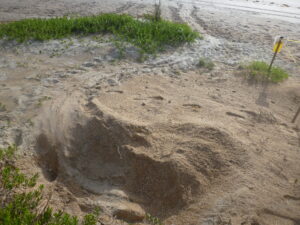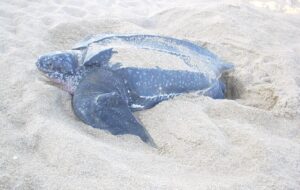New Smyrna Beach hosts three different species of nesting sea turtle: loggerhead, green turtle, and leatherback. Of these, the loggerhead is the most common and the leatherback is the champion in size at over two times the size of the green turtle or the loggerhead. Although hawksbill and Kemp’s ridley sea turtles can also be found in our local waters, no nesting activity has ever been documented in New Smyrna Beach from those species.
Loggerhead Sea Turtles (Caretta caretta)
Loggerhead sea turtles are by far the most common species of sea turtle nesting in New Smyrna Beach. They are distinguished by their large “log-like” heads and heart shaped carapace with five lateral scutes. The sex of the hatchlings is mostly determined by the temperature of the nest, with warmer temperatures producing females and cooler temperatures producing males. Our Volusia County beaches are important because the white, quartz sand is slightly cooler than the beaches further south, therefore, it is thought that our local beaches produce many of the males necessary for the survival of the species.
Mature turtle facts:
Length: 2.5-3.5 feet
Weight: 155-375 lbs
Diet: shellfish such as crabs and conchs
Beach Track: Distinctive beach track with alternating, comma-shaped flipper marks and no tail drag
Status: Threatened
Nesting facts:
Age at Maturity: 30-35 years
Nesting Season: May-October
Nesting Frequency: 2-4 year intervals and lay 3-6 nests per season
Eggs per Nest: average 115
Incubation Period: 50-60 days




Green Sea Turtles (Chelonia mydas)
Green sea turtles have a unique starburst pattern on their carapace and are nearly white on the underside with a serrated lower jaw and four lateral scutes. They are mainly vegetarians and this diet gives them a layer of greenish-colored fat from which they take their name.
Mature turtle facts:
Length: 3-4 feet
Weight: 240-420 pounds
Diet: Sea grasses and algae as adults
Beach Track: Distinctive beach track with parallel flipper marks and nearly always a tail drag
Status: Threatened
Nesting facts:
Age at Maturity: 20-40 years
Nesting Season: June-November
Nesting Frequency: 2 year intervals and lay 3-5 nests per season
Eggs per Nest: average 135
Incubation Period: 50-60 days




Leatherback sea turtles (Dermochelys coriacea)
Leatherbacks are the largest of all the sea turtles and can weigh over a thousand pounds. They are characteristically black with white splotches and thin, rubbery skin with seven ridges of bony plates running down their backs. They can travel thousands of miles and dive almost a mile deep. Their beach tracks cannot be mistaken for any other sea turtle tracks because they’re so much larger at over 4 feet wide. Their eggs are also larger than green turtle or loggerhead eggs, approximately billiard ball sized as compared to ping pong ball sized. The highest number of leatherback nests ever recorded on New Smyrna Beach was 13 in 2011.
Mature turtle facts:
Length: 4-6 ft
Weight: 660-1100 lbs
Diet: Jellyfish
Beach Track: Over 4 ft. wide with parallel flipper marks and a deep ridge down the center from tail drag
Status: Endangered
Nesting facts:
Age at Maturity: 9-20 years
Nesting Season: March-June
Nesting Frequency: 2-3 year intervals and lay 4-7 nests per year
Eggs per Nest: average 73 and 30 unfertilized “spacer” eggs
Incubation Period: 60-75 days



